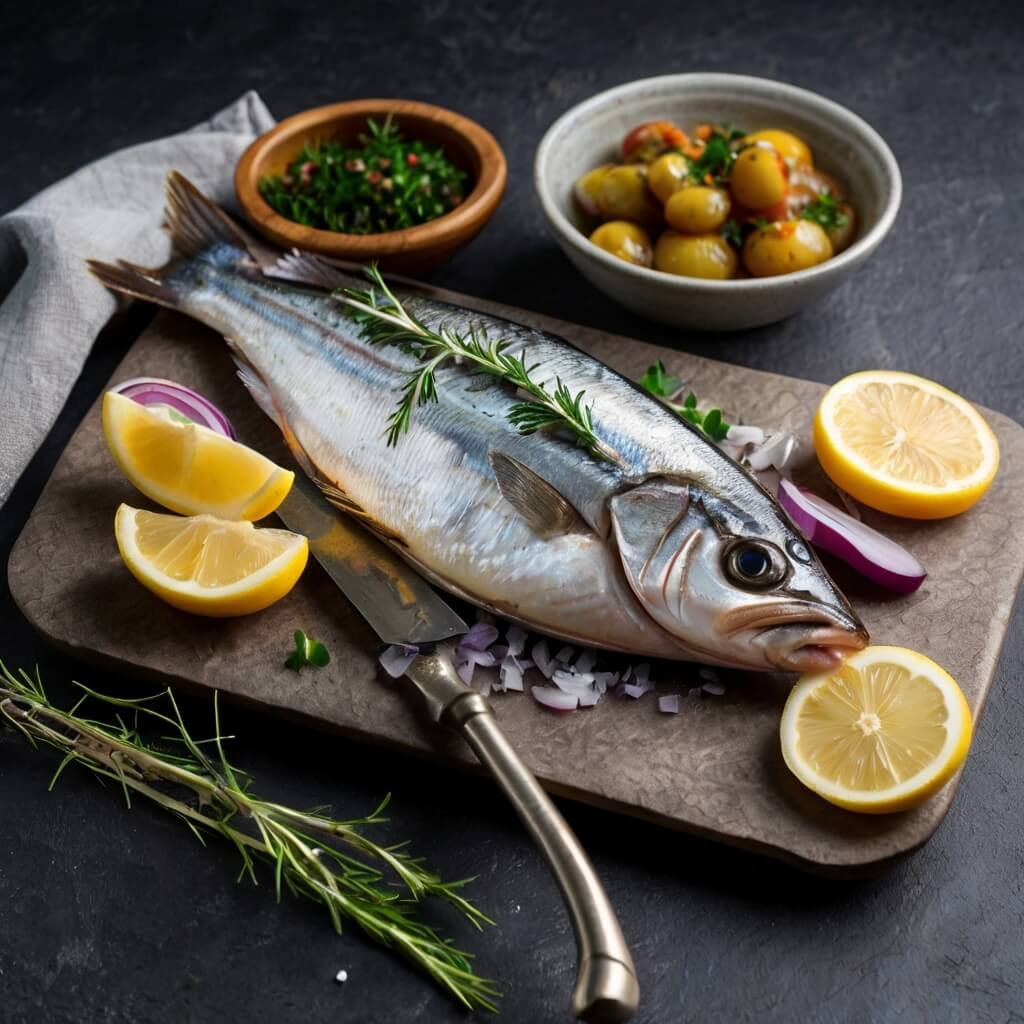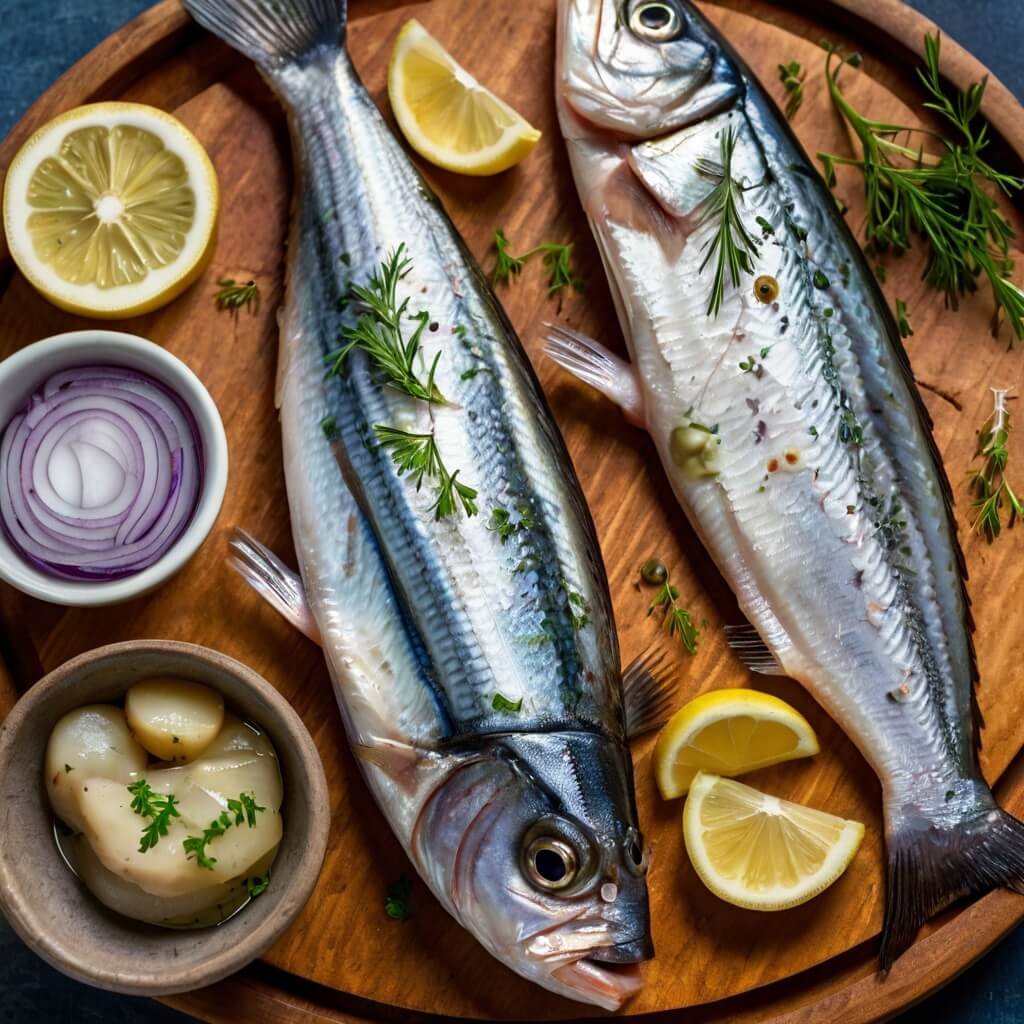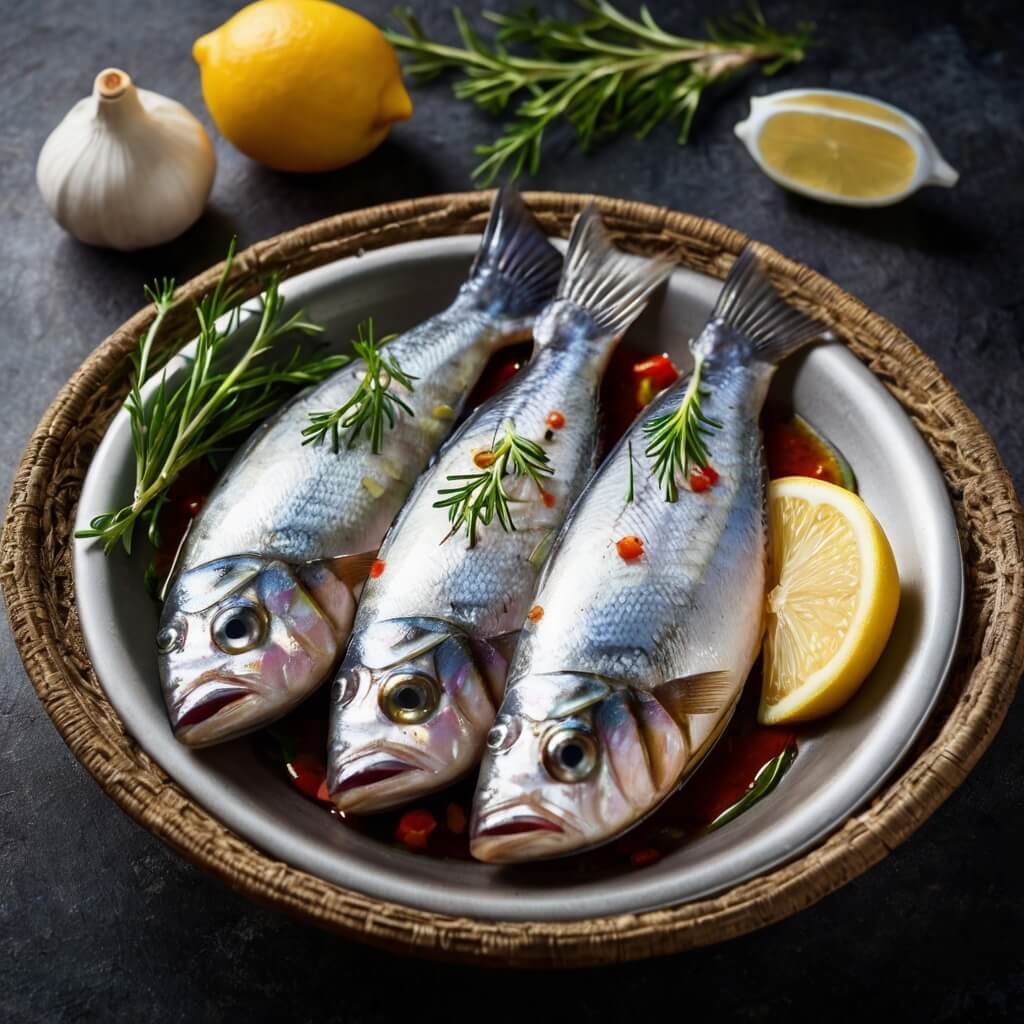Herring is a culinary gem enjoyed in various cuisines, from the Baltic region to the Mediterranean. Despite its small size, this fish has secured its spot in numerous traditional dishes, providing both delicious flavors and impressive health benefits.
Key Nutritional Benefits:
- Rich in omega-3 fatty acids (1,800mg per 100g serving)
- High-quality protein content
- Essential vitamins D and B12
- Abundant minerals including selenium and iron
What makes herring truly special is its versatility in cooking. There are several methods used to prepare this fish, each resulting in distinct flavors and textures:
- Pan-fried: Creates a crispy exterior while maintaining tender flesh
- Pickled: Develops complex flavors perfect for appetizers
- Smoked: Offers intense depth and preserves the fish naturally
- Baked: Provides a healthy, simple preparation method
- Roasted: Brings out natural oils and enhances taste
From Swedish surströmming to British kipper snacks, herring adapts to regional tastes and cooking styles. Whether you’re an experienced chef or an adventurous home cook, herring offers endless possibilities to explore traditional recipes and create modern interpretations.
Ready to master herring preparation? Let’s dive into five simple steps that will transform you into a herring cooking expert.

Step 1: Choosing the Right Herring
Your herring selection sets the foundation for a successful dish. Let’s explore the main varieties you’ll encounter at markets and specialty stores:
1. Fresh Herring
- Bright, clear eyes and metallic-silver skin
- Firm flesh that springs back when pressed
- Clean, ocean-fresh scent
- Best used within 1-2 days of purchase
- Perfect for grilling, pan-frying, or baking
2. Smoked Herring
- Rich golden-brown color
- Firm, slightly dry texture
- Intense smoky aroma
- 2-3 week shelf life when refrigerated
- Ideal for pasta dishes and salads
3. Pickled Herring
- Plump, white flesh
- Tender but firm texture
- Packed in vinegar or wine sauce
- 3-4 month shelf life when unopened
- Great for traditional Scandinavian dishes
Quality Check Tips
- Fresh herring should never smell fishy or ammonia-like
- Avoid fish with yellowing around the edges
- Check for intact scales and clear mucus coating on fresh varieties
- Preserved herring should have clear, unclouded brine
- Examine packaging dates and storage instructions
Seasonal Buying Guide
- Atlantic herring peaks from May to October
- Pacific herring runs from December to February
- Fresh herring prices drop during peak seasons
- Preserved varieties maintain consistent pricing year-round
The right herring choice depends on your recipe requirements and cooking method. Fresh herring demands immediate preparation, while preserved varieties offer convenience and distinct flavors for specific dishes.
Step 2: Preparing Herring for Cooking
Preparing fresh herring requires attention to detail and proper technique. Here’s your step-by-step guide to clean and fillet herring:
1. Cleaning Fresh Herring
- Remove scales by scraping against the grain with a knife
- Cut off the head behind the gills
- Make a shallow cut along the belly
- Remove internal organs and rinse thoroughly
- Pat dry with paper towels
2. Filleting Technique
- Place the herring on its side
- Cut along the backbone from head to tail
- Lift the fillet while cutting away from the bones
- Remove any remaining small bones with tweezers
- Repeat on the other side
Marinating Tips for Enhanced Flavor
Classic Mustard-Cream Marinade:
- 2 tablespoons Dijon mustard
- 1/4 cup heavy cream
- 1 teaspoon white pepper
- Fresh dill, chopped
Brining Guide for Salted Herring
Basic Brine Recipe:
- 1 cup kosher salt
- 4 cups water
- 2 bay leaves
- 6 peppercorns
Brining Time Guide:
- Small fillets: 4-6 hours
- Whole fish: 8-12 hours
- Thick pieces: 12-24 hours
Keep your herring submerged in the brine solution in a glass or ceramic container. Store in the refrigerator during the brining process. Rinse thoroughly before cooking to remove excess salt.

Step 3: Exploring Different Cooking Methods for Herring
Herring’s versatility opens up a wide range of cooking options. Let’s explore these tried-and-true methods that enhance the flavors of this nutritious fish.
A. Frying Herring to Perfection
Frying herring is an art that creates a delightful contrast between crispy skin and tender flesh. Here’s a foolproof recipe for oat-crusted fried herring:
Ingredients:
- 4 herring fillets
- 1 cup rolled oats
- 2 eggs, beaten
- Salt and black pepper
- Vegetable oil for frying
- 1 lemon, cut into wedges
Instructions:
- Pat the herring fillets dry with paper towels
- Season both sides with salt and pepper
- Dip each fillet in beaten egg
- Press the fillets into rolled oats, ensuring even coating
- Heat oil in a heavy-bottomed pan until shimmering
- Fry fillets for 3-4 minutes per side until golden brown
Pro Tips:
- Keep oil temperature at 350°F (175°C) for optimal crispiness
- Don’t overcrowd the pan – fry in batches if needed
- Place fried fillets on paper towels to absorb excess oil
The perfect fried herring should have a golden-brown crust with a moist, flaky interior. The oats add a nutty flavor and satisfying crunch that complements the fish’s natural richness.
While frying is a popular method, you might also consider air frying for a healthier alternative that still delivers on taste and texture.
- Boiled new potatoes with dill
- Homemade remoulade sauce
- Pickled cucumbers
- Fresh lemon wedges
- Crisp green salad
Your remoulade sauce can be prepared by mixing:
- 1 cup mayonnaise
- 2 tablespoons chopped capers
- 1 tablespoon Dijon mustard
- 1 tablespoon chopped fresh herbs
- 1 minced shallot
This classic preparation method highlights herring’s natural flavors while adding textural elements that make each bite
B. Preserving the Flavor: Pickling Herring
Pickling herring creates a delightful balance of sweet, sour, and savory flavors that can last for weeks in your refrigerator. Here’s a classic Scandinavian-inspired pickling recipe that brings out the best in this versatile fish:
Classic Pickled Herring Recipe:
- 2 pounds cleaned herring fillets
- 2 cups white vinegar
- 1 cup water
- 1/2 cup sugar
- 2 tablespoons dill seeds
- 1 tablespoon mustard seeds
- 2 bay leaves
- 1 sliced red onion
- 4 whole peppercorns
Instructions:
- Soak herring in cold brine (1 cup salt per 4 cups water) for 12 hours
- Rinse thoroughly and pat dry
- Combine vinegar, water, sugar, and spices in a pot
- Bring mixture to a boil, then let cool completely
- Layer herring and onions in glass jars
- Pour cooled pickling liquid over fish
- Refrigerate for 24 hours before eating
You can serve pickled herring straight from the jar as a traditional smörgåsbord appetizer. The pickled fish also shines in creative dishes:
Serving Suggestions:
- Diced in creamy potato salads
- Mixed with sour cream and apples for a traditional Nordic salad
- Layered on dark rye bread with butter and fresh dill
- Tossed in grain bowls with roasted vegetables
- Added to fresh green salads for extra protein
For a unique twist, consider trying mustard herring, which incorporates mustard seeds into the pickling process for an extra layer of flavor.
C. Infusing Smoky Goodness: Smoking Herring
Smoking herring at home creates a rich, complex flavor that rivals store-bought varieties. You can achieve professional results using either a stovetop smoker or your home oven.
Stovetop Smoking Method:
- Line your stovetop smoker with aluminum foil
- Add 2 tablespoons of wood chips to the base
- Place herring fillets on the rack, skin-side down
- Smoke on medium heat for 15-20 minutes
Oven Smoking Method:
- Create a makeshift smoker using a deep roasting pan
- Place wood chips in a small metal container at the bottom
- Position a wire rack above the chips
- Cover tightly with foil
- Smoke at 200°F (93°C) for 1-2 hours
Wood Chip Selection Guide:
- Alder: Light, sweet flavor – perfect for beginners
- Oak: Strong, traditional taste
- Apple: Mild, fruity notes
- Cherry: Sweet and delicate flavor
- Maple: Subtle sweetness
The key to successful smoking lies in maintaining a consistent temperature. Your herring should reach an internal temperature of 145°F (63°C). The flesh will turn opaque and flake easily when done.
For extra flavor, brine your herring in a salt solution for 2 hours before smoking. Add crushed garlic, bay leaves, or peppercorns to the brine for additional depth.
If you’re interested in expanding your smoking repertoire beyond herring, consider trying smoked mackerel, which offers a similar rich flavor profile and can be prepared using the same methods outlined above.
D. Baking or Roasting Herring for Easy Meal Prep
Baking herring opens up many options for meal prep while keeping its rich, natural flavors intact. This hands-off cooking method allows you to make multiple servings at once – ideal for busy weeknight dinners or batch cooking sessions.
Simple Herb-Stuffed Roasted Herring Recipe:
Ingredients (serves 4):
- 4 whole herrings, cleaned and gutted
- 8 lemon slices
- Fresh herbs (dill, parsley, thyme)
- 2 tbsp olive oil
- Salt and pepper to taste
Instructions:
- Preheat oven to 400°F (200°C)
- Pat herrings dry with paper towels
- Season cavity with salt and pepper
- Stuff each herring with lemon slices and herb sprigs
- Brush with olive oil
- Place on a lined baking sheet
- Bake for 15-20 minutes until flesh flakes easily
Storage Tips:
- Store cooked herring in airtight containers
- Keeps fresh for 3-4 days in refrigerator
- Portion into individual servings before storing
You can customize your baked herring with different herb combinations or create foil packets with vegetables for complete meals. Try adding sliced fennel, cherry tomatoes, or baby potatoes to the baking sheet for a delicious one-pan dinner.
Quick Tip: Double the recipe and freeze extra portions for up to 3 months. Thaw overnight in the refrigerator and reheat gently in the oven at 350°F (175°C) for 10 minutes.
E. Mediterranean-inspired Dishes Featuring Herring
Transform your herring into a delightful Mediterranean feast with a vibrant linguine dish that captures the essence of coastal Italian cuisine. This recipe brings together the rich flavors of herring with classic Mediterranean ingredients.
Mediterranean Herring Linguine Recipe
Ingredients:

- 1 pound linguine pasta
- 2 herring fillets, flaked
- 4 cloves garlic, minced
- 3 tablespoons capers
- 1 cup cherry tomatoes, halved
- 1/4 cup extra virgin olive oil
- 1/2 cup dry white wine
- Fresh basil leaves
- Red pepper flakes
- Sea salt and black pepper
Cooking Instructions:
- Cook linguine in salted water until al dente
- Heat olive oil in a large pan
- Sauté garlic until fragrant
- Add capers and cherry tomatoes
- Pour in white wine and simmer
- Gently fold in flaked herring
- Toss with cooked pasta
- Garnish with fresh basil
The herring’s natural oils create a luxurious sauce when combined with the wine and olive oil. The capers add a briny punch that complements the fish perfectly, while the cherry tomatoes provide bursts of sweetness. This dish works beautifully with both fresh and smoked herring varieties.
Chef’s Tip: Reserve 1/2 cup of pasta cooking water to achieve the perfect sauce consistency. Add it gradually while tossing the pasta with the herring mixture.
Step 4: Creative Serving Ideas that Elevate Your Herring Dishes
Transform your herring dishes from simple meals to stunning presentations with these creative serving ideas:
1. Classic Scandinavian Board
- Arrange pickled herring on a rustic wooden board
- Add fresh dill sprigs and lemon wedges
- Include small bowls of sour cream and chopped red onions
- Serve with dark rye bread slices and butter curls
2. Colorful Herring Platters
- Layer smoked herring with roasted bell peppers
- Garnish with fresh herbs and microgreens
- Drizzle with extra virgin olive oil
- Add edible flowers for visual appeal
3. Modern Tapas Style
- Present fried herring bites on individual spoons
- Top with pickled cucumber and radish
- Add dots of wasabi mayo or horseradish cream
- Sprinkle with black sesame seeds
4. Herring Canapés
- Place herring pieces on pumpernickel squares
- Top with crème fraîche and caviar
- Garnish with fresh chives
- Arrange in a circular pattern on a serving plate
5. Temperature Contrasts
- Serve warm fried herring alongside chilled potato salad
- Add pickled vegetables for texture
- Include warm crusty bread
- Finish with cold cucumber yogurt sauce
6. Seasonal Presentations
- Summer: Serve with fresh garden salads and edible flowers
- Fall: Pair with roasted root vegetables
- Winter: Present with warm grain salads
- Spring: Accompany with fresh pea shoots and asparagus
5: Exploring International Flavors through Herring Recipes
Herring’s versatility shines through diverse cultural interpretations across the globe. Let’s explore signature herring dishes that showcase international culinary traditions:
Scandinavian Classics
- Matjes Sill (Sweden) – Young herring fillets cured in spiced brine, served with sour cream, chives, and new potatoes
- Surströmming (Sweden) – Fermented herring paired with tunnbröd, butter, and diced onions
- Sild og Kartofler (Denmark) – Curried herring served on dark rye bread with eggs and fresh dill
Eastern European Treasures
- Śledź w Śmietanie (Poland) – Herring in sour cream sauce with apples and onions
- Selyodka pod Shuboy (Russia) – Layered salad with herring, potatoes, carrots, and beets
Asian-Inspired Preparations
- Nishin Soba (Japan) – Herring-topped buckwheat noodles in hot broth
- Herring Kimchi (Korea) – Spicy fermented herring with traditional kimchi seasonings
Mediterranean Twists
- Aringa Marinata (Italy) – Marinated herring with pine nuts, raisins, and white wine vinegar
- Arenque en Escabeche (Spain) – Pickled herring with olive oil, paprika, and bay leaves
These international recipes demonstrate herring’s adaptability to different spice profiles and cooking techniques. Each culture brings unique ingredients and methods to transform this humble fish into remarkable dishes.
Conclusion
Herring is a nutrient-rich fish that offers numerous health benefits and culinary possibilities. With its high omega-3 fatty acid content, protein, vitamin D, and B12, herring can be a valuable addition to your diet.
Whether you prefer simple preparations or more complex dishes, herring can easily adapt to your cooking style and preferences. Start with basic recipes and gradually explore different ways of preparing this versatile fish.
Make herring a regular part of your meals, whether it’s a quick weeknight dinner or an impressive weekend gathering. By doing so, you’ll not only enjoy the delicious flavors but also reap the nutritional rewards.
So why wait? Begin your herring cooking adventure today! Visit your local market to find fresh herring, experiment with various recipes, and discover your own unique way of enjoying this delightful fish. The options are limitless, and your taste buds will be grateful.
FAQs (Frequently Asked Questions)
What are the nutritional benefits of herring?
Herring is a versatile fish known for its rich omega-3 fatty acid content, which supports heart health and brain function. It also provides essential vitamins and minerals, making it a nutritious addition to various diets.
What types of herring can I find in the market?
You can find several types of herring in the market, including fresh, smoked, pickled, canned, salted, and marinated varieties. Each type has unique characteristics; for example, fresh herring is great for frying or baking, while pickled herring is ideal for salads and snacks.
How do I clean and prepare fresh herring for cooking?
To clean fresh herring, start by removing the scales using a fish scaler or knife. Then, gut the fish by making a small incision along the belly and removing the innards. Filleting involves cutting along the backbone to separate the flesh from the bones. Marinating can enhance flavor; consider using mustard and cream for added taste.
What are some popular cooking methods for preparing herring?
Herring can be prepared using various cooking methods such as frying, pickling, smoking, baking, and roasting. Each method brings out different flavors; for instance, frying with oats creates a crispy texture while smoking infuses a rich smoky flavor.
Can you suggest serving ideas for cooked herring dishes?
Innovative serving ideas include pairing fried herring with boiled potatoes or tangy remoulade sauce. Pickled herring can be served on rye bread or as part of a salad. Experimenting with Mediterranean-inspired dishes like linguine with sautéed garlic and capers can also elevate your meals.
How can I explore international flavors through herring recipes?
You can explore international flavors by trying unique recipes that feature herring as a key ingredient. For example, Scandinavian-inspired dishes often include pickled fish varieties that highlight local spices and preparation techniques. This culinary journey allows you to enjoy diverse tastes from around the world.
